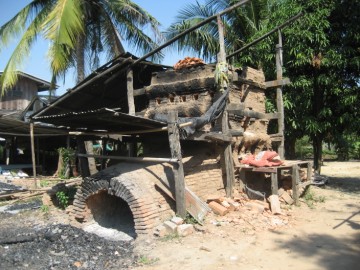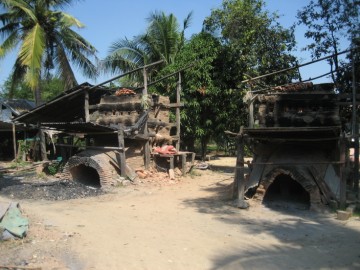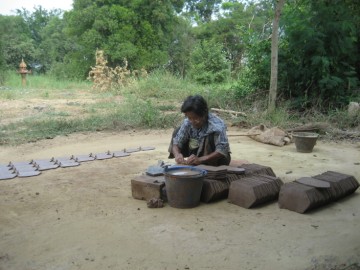| KHLONG SRA BUA KILNS |

| Text & photographs by Tricky Vandenberg - March 2011 |
| In the Ayutthayan era, kilns were situated along the banks of Khlong Sra Bua and in the area opposite, where the canal branches off from the former old Lopburi River, along present Khlong Hua Ro. Phraya Boran Rachathanin wrote in his document "Ruam Rueang Krung Kao" (รวมเรื่องกรุงเก่า) that above Ayutthaya's city island there were five villages, one of which was making potteries and various kinds of tiles. This area was called Thung Khwan and the opposite area Thung Kaeo (Thung Khwan is the area west of Khlong Sra Bua and Thung Kaeo is the area east of Khlong Sra Bua, mainly located in present Khlong Sra Bua sub-district). A number of surface discoveries, such as fragments of vases, earthen pots and tiles, along the banks of Khlong Sra Bua, led to the assumption that there could have been kilns before in this area. Traces of a former kiln construction were already found near the Elephant Kraal. This site can be easily visited in combination with a trip to the kraal. The 3th Region of the Fine Arts Department under the directorship of Mr. Sod Daeng- Ied undertook excavation works in the period 2000 - 2002 in this area in order to verify if there might have been small tile and pot manufacturing factories. The area was divided in seven zones; three zones in the Khlong Sra Bua area (zone 1- 3), three zones in the Khlong Hua Ro area (zone 4-6) and one zone in the Khlong Mueang area (zone 7). Khlong Sra Bua area had three zones. Zone 1 was the northern part of the canal, in the area from Wat Khrutharam until east of Wat Jong Krom on both banks of the canal. Zone 2 was the central part of the canal from the area east of Wat Jong Klom until the area east of Wat Phra Ngam and finally; Zone 3 was the lower part of the canal from the area east of Wat Phra Ngam until south of Wat Kamphaeng. The area covered was 100 m left and right from the canal. Khlong Hua Ro area had also 3 zones. Zone 4 was the area along Khlong Hua Ro in the vicinity of Wat Khae. Zone 5 was the area along Khlong Hua Ro south of the Elephant kraal. Zone 6 was the area of the junction of Khlong Hua Ro and north of Khlong Mueang, including Wat Mae Nang Plum. The last zone was zone 7 which covered the area north of Khlong Mueang. Thirty test pits were dug. (1) The focus of the excavations turned finally to the Khlong Sra Bua area. The zones 4-6 were less interesting, as this area was the ground of the Royal Elephant Department or Krom Khachapan in the Ayutthayan era. There was as thus not so much evidence of artifacts because at that time settlement was restricted there. Zone 7 is at present densely populated and assumed to have had little to do with pottery or tile manufacturing. Two main manufacturing areas were discovered in the middle to upper western bank and the upper eastern bank of Khlong Sra Bua. The excavation team found out that people lived and worked in the same area as houses were close to the factories. East of Wat Khrutharam was a production area of large earthen pots, jars and massive storage vessels. In this area open bon fire techniques were practiced. Mid Khlong Sra Bua (zone 2) till west of Wat Khrutharam (zone 1) was a production area for various kinds of earthen tiles, mainly flat and cylindrical tiles and other decorative parts, various kinds of antefix tiles, thick square floor tiles. In the latter area remains of oblong updraft kilns were found. In zone 3, artifacts were found being evidence of pottery production. In conclusion we can state that in the Ayutthaya era this area likely provided the construction materials for the building of walls, palaces and temples. Though it should be added that the bricks for the construction of temples mostly were manufactured on the temple's location. An example of this can be found on the premises of Wat Phutthaisawan. Today there are still a few kilns in use. An updraft kiln can be visited east of Khlong Hua Ro (opposite the mouth of Khlong Sra Bua - near the crossing of the road leading to Wat Pom Raman and the road leading to the Elephant Kraal) in Suan Prik sub- district of Ayutthaya. The two updraft kilns can produce either earthen tiles or potteries, but are mainly used for tiles. Tiles manufactured are flat tiles and end pointed flat tiles. People here, are still using the old tile manufacturing techniques, so the site is certainly worthwhile a visit. An updraft kiln is a periodic kiln in which the flame is introduced into the bottom of the kiln, at or below floor level, and exhausted out the top. It consists of three basic components: the firebox, the damper, and the stack area. The firebox is where the flame enters. The damper is at the top of the kiln and controls the exhaust. The stack area is where the pots are set and is between the firebox and damper. Periodic kilns are fired on an intermittent schedule; the kilns are loaded, brought to temperature, cooled, and then unloaded. The kiln is not fired all the time. [2] In the area north of Khlong Sra Bua baked-brick kilns are presently mushrooming. Brick making is at present far more economically than ceramic products, but most of these brick manufacturing sites are in fact newcomers in this area. (2) Footnotes: (1) 15 in zone 1, 5 in zone 2, 4 in zone 3, 2 in zone 4, 3 in zone 5, 1 in zone 6 and 1 in zone 7. (2) Most of this text is based on the document written by Pakpadee Yukongdi [1] References: [1] Development of ceramics production in Ayutthaya - Pakpadee Yukongdi (2009) - Silpakorn University. [2] http://pottery.about.com (defunct) by Beth Peterson - data retrieved 29 March 2011. |









| (Kiln at Wat Phutthaisawan) |
| (Excavation plan with zones by Pakpadee Yukongdi) |
| (Updraft kilns) |
| (Lateral view of an updraft kiln) |
| (Frontal view of an updraft kiln) |
| (Applying a hook to a end pointed flat tile) |
| (Fixing the clay on the mould and use of wooden cutter) |
| (Flat tiles with hook - ridge) |
| (End pointed flat tiles) |